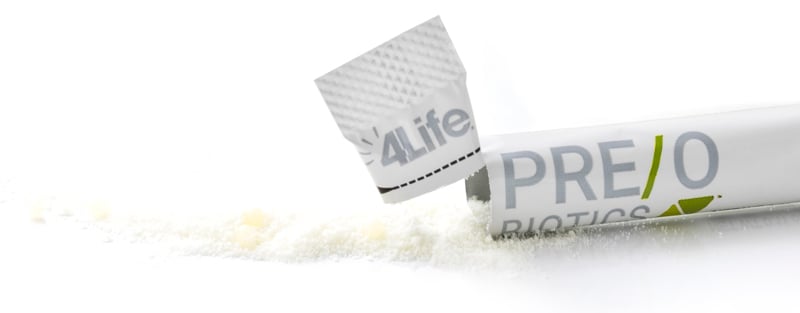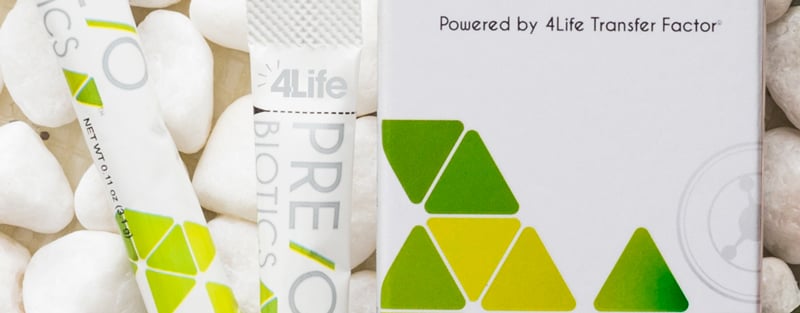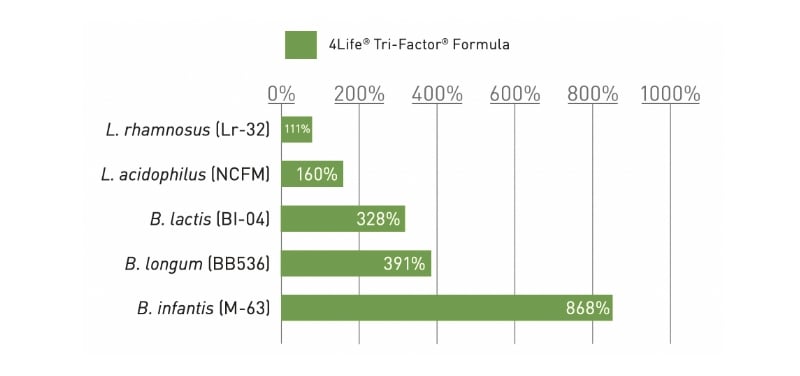-
What role does 4Life Transfer Factor play in Pre/o?
Seventy percent of your immune system resides in your gut. A balanced microbiome is imperative for a healthy immune system. 4Life Transfer Factor is formulated to activate an intelligent immune system response, making its inclusion in Pre/o a no brainer! Plus, recent scientific research shows that 4Life Transfer Factor helps stimulate growth of select microflora up to 868%.*
-
How much Pre/o should I take?
Start your Pre/o supplement regimen with one stick pack every day for one month. After the first month, take one stick pack every other day to maintain microbiome health.*
-
If I have stomach problems or digestive issues, can I still take Pre/o Biotics?
Please consult with your doctor before starting any dietary supplements if you have stomach or digestive issues.
-
What is a prebiotic and why do I need to take one with my probiotic?
Prebiotics are indigestible fibers and partially digestible starches that help maintain and nourish probiotics. Think of prebiotics as food for your microbiome! Probiotics rely on these plant-based fibers (prebiotics) to thrive. Taking a prebiotic with a probiotic can help increase their effectiveness.*
-
Why are the probiotics in a beadlet?
Our one-of-a-kind microbeadlet technology preserves the integrity of the probiotics so you can efficiently utilize all that good stuff you’re putting into your body. Unlike other probiotics, our microbeadlets are tasteless, making them easier to ingest. Plus, their unique timed-release composition ensures that the probiotics within are not released until the beadlet enters the colon. This prevents the loss of probiotics due to release in less hospitable environments. These microbeadlets ensure that nearly 100% of the ingested probiotics make it to their intended destination. That’s why you shouldn’t chew the beadlets. The beadlet form safely delivers the probiotics where they need to go in your body.*
-
Do I need to refrigerate Pre/o?
Unlike other formulas in the market, Pre/o doesn’t need to be refrigerated. To store Pre/o, keep it in a cool, dry place. The probiotics are inside the beadlet, which protects them from outside elements. However, like all probiotics, refrigeration will further extend the shelf life of the product. In other words, refrigeration is not necessary, but it can still help.*
-
What is the difference between “good bacteria” and “bad bacteria” in the gut?
Like most things in life, it’s all about balance. Good bacteria, like those contained in Pre/o, help keep “bad” bacteria in check. Overgrowth of bad bacteria can cause digestive issues and discomfort and weaken the immune system response. By supplementing with probiotics, you’re creating a happy home for your microbiome. The more friendly bacteria you have in your microbiome, the better it will function.*
-
Why do the probiotics in Pre/o have strain numbers?
The strain numbers let you know EXACTLY what you’re getting. It’s not a generic bacteria, it’s the NCFM strain. Not all probiotics behave the same. They may carry the same genus and species, but something deeper in the genetics makes a big difference in how helpful the bacteria is. Strain numbers, in essence, are guaranteed activity. You can look up the strain number and know precisely what that specific bacteria is capable of. Without the strain number, you’re never sure.
-
How do I take Pre/o?
To take Pre/o, pour the entire contents of the stick pack into your mouth. The beadlets should be swallowed whole; DO NOT CHEW. Follow with water or another beverage if desired.
-
At what age can people start taking Pre/o Biotics?
Pre/o is for adults and children ages 4 and above. Children 4−12 years old should only take half a stick pack a day. Children ages 12 and up can take the standard, recommended dose.
-
Are there any common allergens associated with Pre/o?
Pre/o contains ingredients from milk, eggs, soy, fish, and tree nuts.
-
Can I take additional types of probiotics along with Pre/o?
Yes. Just make sure that they, too, have strain numbers.
-
What does CFU stand for on the label?
CFU stands for colony forming unit. The number of CFU helps identify the amount of viable, friendly bacteria that are present.
-
Is Pre/o better than probiotics found in foods?
While good bacteria can be found in foods such as yogurt or kombucha, the amount present isn’t always sufficient to create a lasting impact on microbiome health. Pre/o contains friendly flora in quantities that contribute to a more balanced gut in a relatively short time. Studies on Pre/o showed an increase in the amount and longevity of beneficial gut flora by up to 1,000 times over standard delivery. Additionally, fermented foods typically only contain one bacteria. Pre/o contains five highly beneficial strains.*
-
Is there a certain time of day it is best to take Pre/o?
It’s always a great time to take Pre/o!
-
Can I take Pre/o Biotics when I am taking antibiotics?
In general, it is safe to take a probiotic with antibiotics. In fact, probiotics can help offset the killing of friendly bacteria—a side effect of antibiotics. Consult a physician if you have any questions about interactions between supplements and prescribed medications.
-
Is Pre/o vegan?
No. Pre/o contains 4Life Transfer Factor from milk and eggs. The beadlet shell is also made from fish gelatin.



